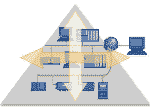 |
 |
Industrial Networks - Plethora of Choices
By : Jim Pinto, The future of the industrial automation environment holds the potential for installation of many different networks that can yield information to improve operations and profitability. The plethora of choices makes decisions difficult. It's important to have a strategy going forward.

Automation.com, May 2008
|
 Companies have lots of choices for installing and using industrial networks. They have to choose not only what's available today, but also be aware of emerging standards. It's important to have a strategy going forward.
Companies have lots of choices for installing and using industrial networks. They have to choose not only what's available today, but also be aware of emerging standards. It's important to have a strategy going forward.
Networks are proliferating, not only in offices and commercial environments, but also in factory and manufacturing processes and throughout the enterprise. The plethora of choices makes decisions difficult. Some end-users simply go with the preferences of a major supplier. But that often boxes them in to an approach which may limit future performance and interoperability between products in different segments of the enterprise. The Fieldbus warsIn the industrial automation business, the old Fieldbus wars resulted in the approval of several different standards for use in various levels of the hierarchy based on physical distance, speed of operation, real-time capabilities and other application specific requirements.The primary IEC standard industrial networks available today are Profibus/Profinet, Foundation Fieldbus, ControlNet, MODbus, HART and several others, total of 15, many of which are recognized only regionally in Europe. In the quest to attract wider usage and interoperability with products from many suppliers, most proprietary networks have become "open" standards. As standards emerge in different industrial environments most major automation companies profess to support all the major standards to provide the product interoperability which their customers, the end-users, seem to expect. But marketing skirmishes continue between the major suppliers regarding solutions for manufacturer-independent field instruments. Naturally, each supplier favors its own proprietary products. There are two approaches for field-device integration: Electronic Device Description Language (EDDL), and field device tool/device type manager (FDT/DTM) technology. Support for FDT/DTM doesn't imply rejection of EDDL, since EDDL files and DTMs work together to provide the needed system features. But the discussion on technical and marketing advantages continues. In my opinion, the differences between EDDL and FDT/DTM are not technical, but primarily come from major companies who want to retain their lead, rather than diffuse it by allowing others to participate through a technical "back door". The continued discussions regarding the simple description of two standards that don't conflict bring up subtleties that cannot be explained except as "obfuscation". And so this extension of the Fieldbus wars continues. Wireless networksIndustrial wireless has become a major standards battleground over the past couple of years because the industrial automation business is projected to generate significant growth in this arena. Wireless networks in the factory and process plant are becoming as important as the Internet has been in the business environment. Just as the Internet allows access to digital information everywhere, sensor and actuator networks will provide vast arrays of real-time, remote measurements, controls and interaction with the physical world.Industrial networks will quickly become integrated with standard plant and office WiFi, WiMax and broadband IT networks. Cisco, the mainstream networking "big gorilla", is following the growing convergence of the IT and automation worlds and has entered the industrial automation arena, hoping to extend its reach from the corporate level to the plant and factory. It's important to remember that while the process automation majors are primarily focused on the benefits of wireless-enabled versions of conventional field devices, the full range of potential applications of wireless technology in industrial automation applications is considerably wider and deeper. There are lots of measurement and control applications which can use the versatility of wireless, and this will contribute to substantial market growth. Wireless WarsThe continuing disputes and delays over wireless standards are really marketing ploys to gain market-share through the differentiations that support the major automation companies' market strategies.Emerson and others are focused primarily on wireless standards for field devices. On the other hand, Honeywell and others wants standards for much broader lines of measurement and control products, located throughout process plants and requiring wireless communications with a much wider variety of devices and systems. In 2007, WirelessHart was announced as the first open wireless communication standard specifically designed for process measurement and control field instruments. This specification was developed through the cooperative efforts of several major companies in the automation industry. The concept of self-healing mesh networking, based on Dust Networks' WSN (Wireless Sensor Networking) and its TSMP (Time Synchronized Mesh Protocol) is the foundational building block of the WirelessHART standard. Vendors of HART-based field devices should be able to develop compatible versions quickly, with wireless retrofit kits for already widely deployed hard-wired HART devices. That's a significant market. However, Honeywell and others have protested that the industry should wait for the not-yet-ready ISA-100 standard which is being developed to support multiple protocols, such as Hart, Profibus, CIP and Foundation Fieldbus, instead of just WirelessHart. After an initial skirmish, ISA and the HART foundation established a joint technical committee to assess the degree to which WirelessHART technology meets the ISA's objectives and whether it can be incorporated into what is now being called "the ISA-100 family of standards". In mid-2008, more than a half-year after the joint ISA/HART collaboration was launched, the 51 members of the committees and subcommittees have still not reached any agreement. So, the "wireless wars" drag on. This seems remarkably like what happened when several, mutually incompatible protocols were incorporated into the IEC standard to eventually resolve the "Fieldbus wars" that started almost 2 decades ago. Some 15 different industrial networking protocols were eventually approved as "standards". Undoubtedly, the "Wireless Wars" will eventually be resolved in a similar fashion. Industrial EthernetEthernet is everywhere. It's almost universal in the business environment and extends to factory and process automation environments even down to the device level. For industrial networking, the big advantage is the ability to connect everything - from the plant floor to the corporate boardroom - on one network, providing access to data throughout the enterprise from anywhere around the world.Some advocate industrial versions of Ethernet. This term extends beyond simply more rugged hardware connections to the use of industrial protocols and real-time extensions of TCP/IP. The fundamental characteristic of Ethernet networks at any speed is that the average delivery speed degrades in a non-linear way with loading. Device response times cannot be guaranteed because of data collisions and delays in retransmitting data. The question of whether Ethernet will penetrate right down to the field level has become closely linked to the real-time issue. The clear advantages have brought many automation world enhancements to Ethernet standards, especially in areas of determinism, speed and prioritization. For most factory automation applications, 100 Mbps Ethernet is deterministic enough. There is no longer any reason why Ethernet cannot be used to build deterministic, open and inexpensive automation network solutions. The traditional industrial automation majors are clearly on the Ethernet bandwagon. For example, Rockwell Automation, Siemens and others claim that up to 70-80 percent of their automation products are Ethernet-enabled. Clearly, automation and control products must have Ethernet connectivity. The real question is whether to connect directly on Ethernet, or indirectly via one of the entrenched industrial networks. It must be recognized that Ethernet alone does not guarantee that two devices can talk to each other. There must be compatibility at the application layers. To make this happen, a common data model is needed, that allows the porting of application-layer software from one platform to another. As the major industrial networks become more entrenched, it seems sensible to move forward with mixed systems. In my opinion, more and more users will take the step of an industrial Ethernet solution with minimal systems interface and direct connect to the input/output layer. The Pervasive InternetThe spread of wired and wireless connectivity will eventually reach tens of billions of connections. Machines will communicate with each other, as well as with data mining and processing systems that will automate the communication and interpretation of the mass of data they gather. This will add significant value for all businesses, suppliers and end-users alike.The term "Pervasive Internet" refers to the convergence of machine-to-machine communications, Internet connectivity, enterprise-level data-management applications, and Web-based smart services. The phenomenon arises from the connection of smart devices to the Internet, enabling fully automated global communication, data-collection and control. Wireless could significantly change the architecture of industrial automation systems by using, distributed intelligent sensors and actuators, remote from central control and monitoring systems. Today, a whole new environment of machine-to-machine (M2M) communications is emerging, focused on the issues of how machines communicate, how they are managed, how the data and information within them are managed, and perhaps most importantly, how the world (humans, businesses and society) can deal with them. The convergence of smart devices with the Internet is creating a profound shift in the development of the digital revolution – creating a global "digital nervous system." The exponential growth of device networking technology is changing the landscape very quickly. Products and companies that fail to exploit this next wave of the digital revolution will simply obsolete themselves. Huge opportunities will arise from the convergence of device networking, wireless sensors and actuators, machine-to-machine (M2M) communication, and the Internet. The eventual goal will be to network devices that are self-sensing, self-controlling, and self-optimizing automatically, without human intervention. This represents totally new applications for information technology and telecom which will totally subsume previous business models. ConclusionThe future of the industrial automation environment holds the potential for significant, yet inexpensive, installation of many different networks throughout a plant that can yield tremendous information for managers to use to improve operations and profitability.Related links:

|
 Pinto's Points How to win in the Automation Business Go shopping - books, electronics, CD/DVD Selected advertising coming here. Contact Jim Pinto for rates. |
Return to Index of all JimPinto Writings

 Return to JimPinto.com HomePage
Return to JimPinto.com HomePage
If you have ideas or suggestions to improve this site, contact: webmaster@jimpinto.com
Copyright 2006 : Jim Pinto, San Diego, CA, USA
